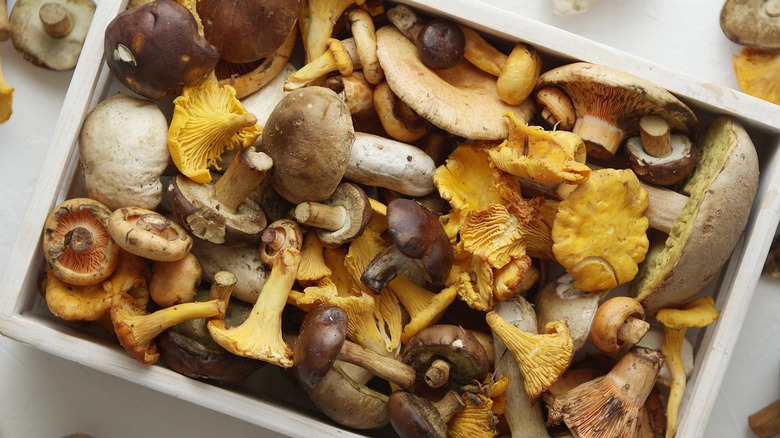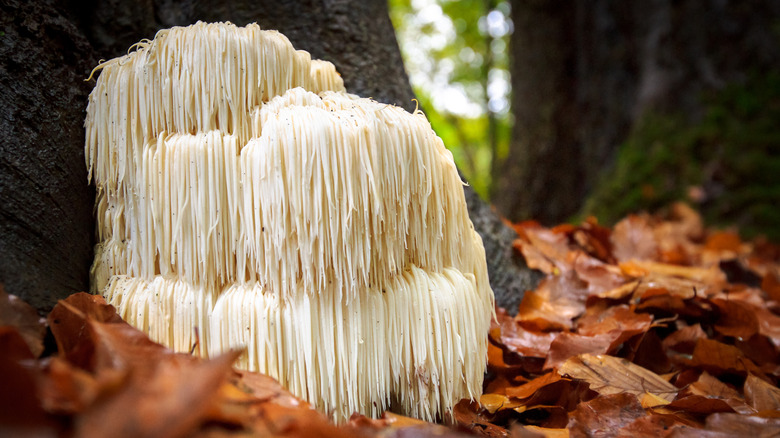Read This Before Trying To Cook The Mysterious Lion's Mane Mushrooms
In the culinary world, mushrooms are having a moment. The types of mushrooms available in grocery stores and farmers' markets have expanded far beyond common varietals, such as white button and portobello. Cremini, shitake, porcini, and oyster mushrooms have all made their way into shopping carts and home kitchens by now. But one type of mushroom remains somewhat elusive, despite its incredible flavor and a myriad of health benefits: the Lion's Mane mushroom.
Lion's Mane mushrooms can be found in the wild, growing on dead or dying hardwood trees. This type of mushroom is favored by foragers, as it doesn't resemble any toxic or poisonous mushrooms. Lion's Mane looks very different from other mushrooms, which can be intimidating or off-putting. But there's no need to shy away from it, as it's easy to prep. So easy, in fact, it doesn't even need to be rinsed — in fact, it shouldn't be.
How to tame the king of all mushrooms
The Lion's Mane mushroom grows wild in hardwood forests across the northern hemisphere from July through October. While they may look more like a floor mop than a delicacy, they're completely safe to eat and relatively easy to prepare. The key thing to remember? Don't wash or scrub them before eating. Lion's Mane mushrooms are highly absorbent, meaning too much water can render them soggy and dull their flavor. Instead, Cascadian Mushrooms recommends using a dry brush to gently clear away dirt.
Once they're clean and dry, Lion's Mane mushrooms can be roasted or sautéed like any other mushroom and used in your favorite mushroom recipes, such as a ramp and mushroom sauté. Their flavor is comparable to buttery seafood, with a texture described as being similar to crab. This makes Lion's Mane mushrooms a great choice for vegan or vegetarian sushi, replacing crab in a traditional California roll or seafood salad.
Lion's Mane mushrooms' dense texture also means they can stand up to deep frying and hold their own in soups and stews, lending texture to cream of mushroom soup recipes.
Mushrooms as medicine
As more people opt for vegan and vegetarian diets, the demand for a wider variety of meat substitutes has increased. Mushrooms are a good source of protein and are rich with nutrients, including selenium and vitamin D (which can't be found in any other produce). Fans of the fungi's meaty texture and umami flavor are growing, and so is the market. According to one report from Grand View Research, global mushroom sales are expected to grow nearly 10% annually for the next seven years. That may be because mushrooms are more than just food.
While it may be relatively new in North America, Lion's Mane has been used in traditional Chinese medicine for centuries. Buddhist monks drank tea made from powdered Lion's Mane to enhance clarity and perception during meditation. In fact, the Japanese word for Lion's Mane translates to "mountain monk mushroom."
According to the Association for the Advancement of Restorative Medicine, Lion's Mane is beneficial to the internal organs, including the heart, lungs, and kidneys. It's even been used to treat cancer. Some AARM studies also found it had "statistically significant improvement in spatial short-term and visual recognition memory" and may be effective in treating Alzheimer's disease, due to its ability to increase brain cell growth and improve memory. It's also a good source of antioxidants and potassium, and early clinical studies show it may be able to reduce stress, depression, and anxiety.


